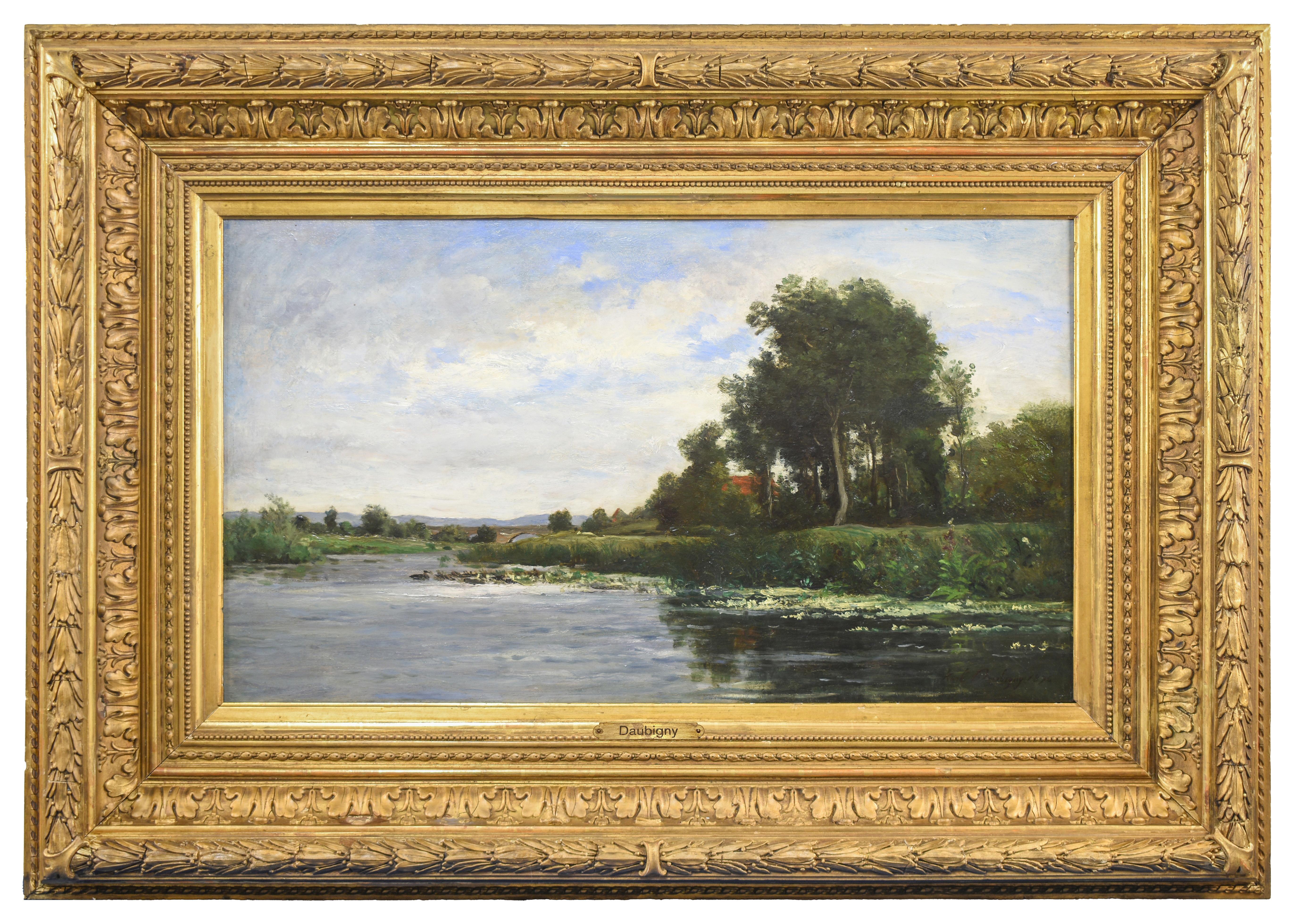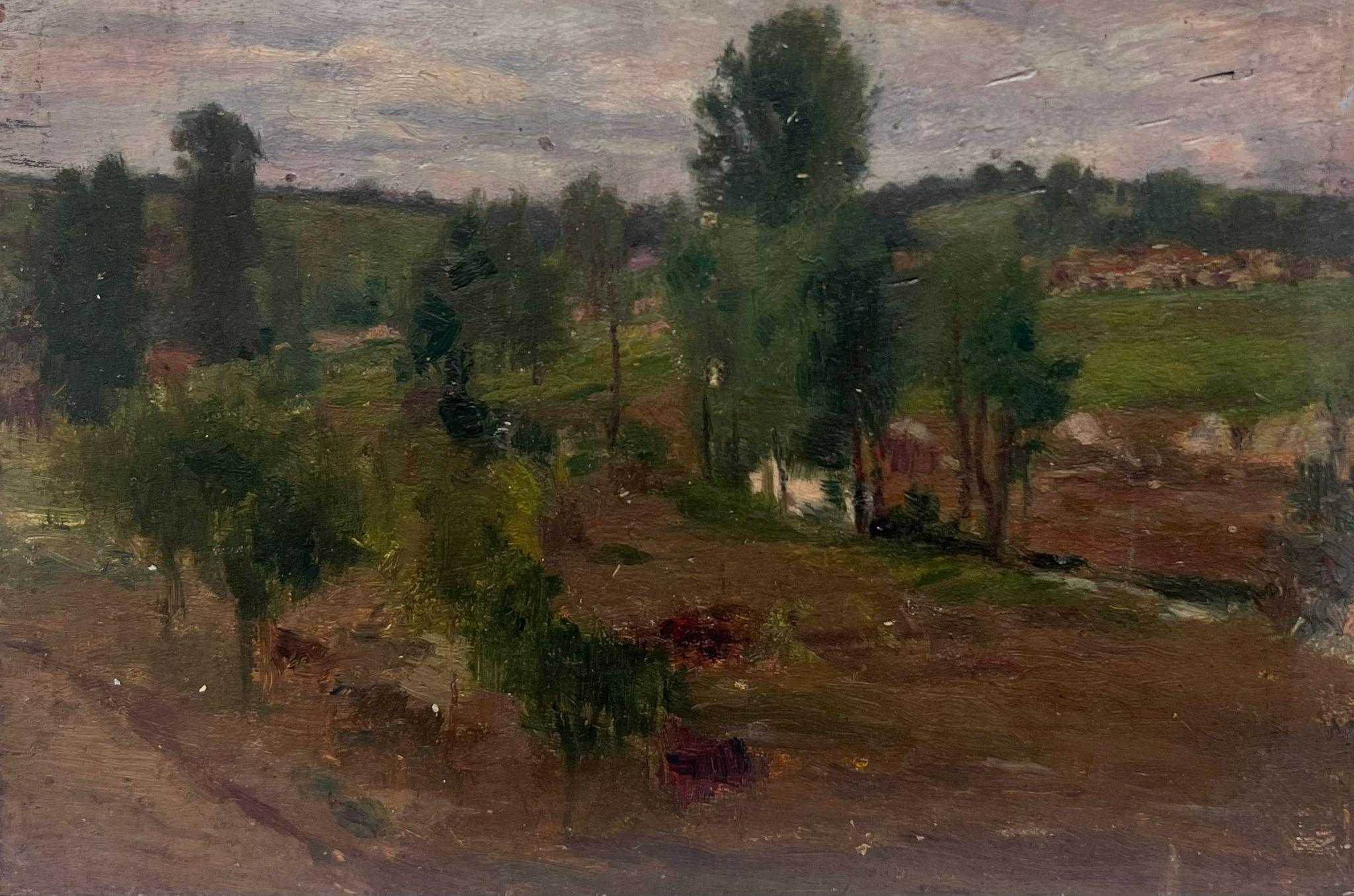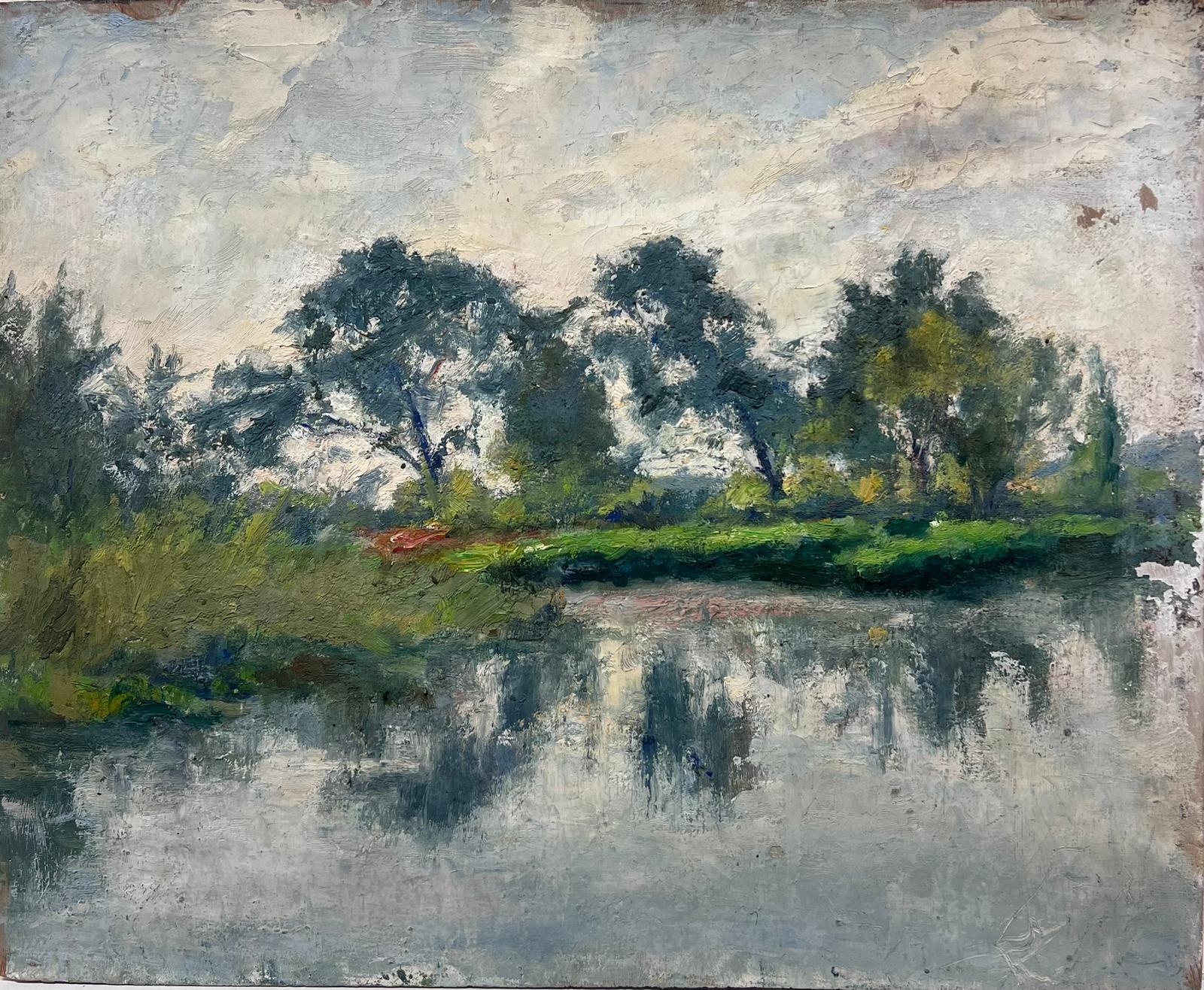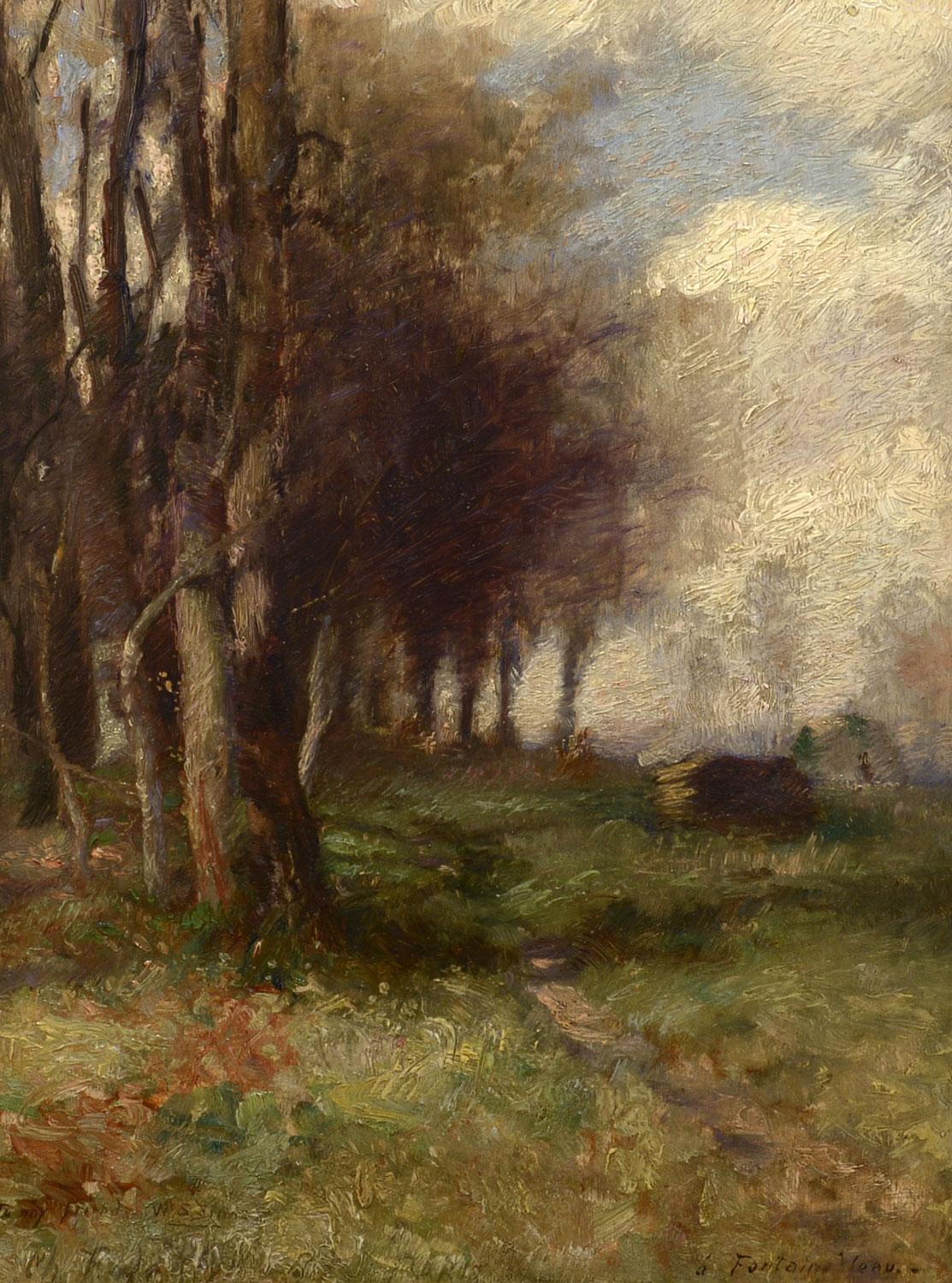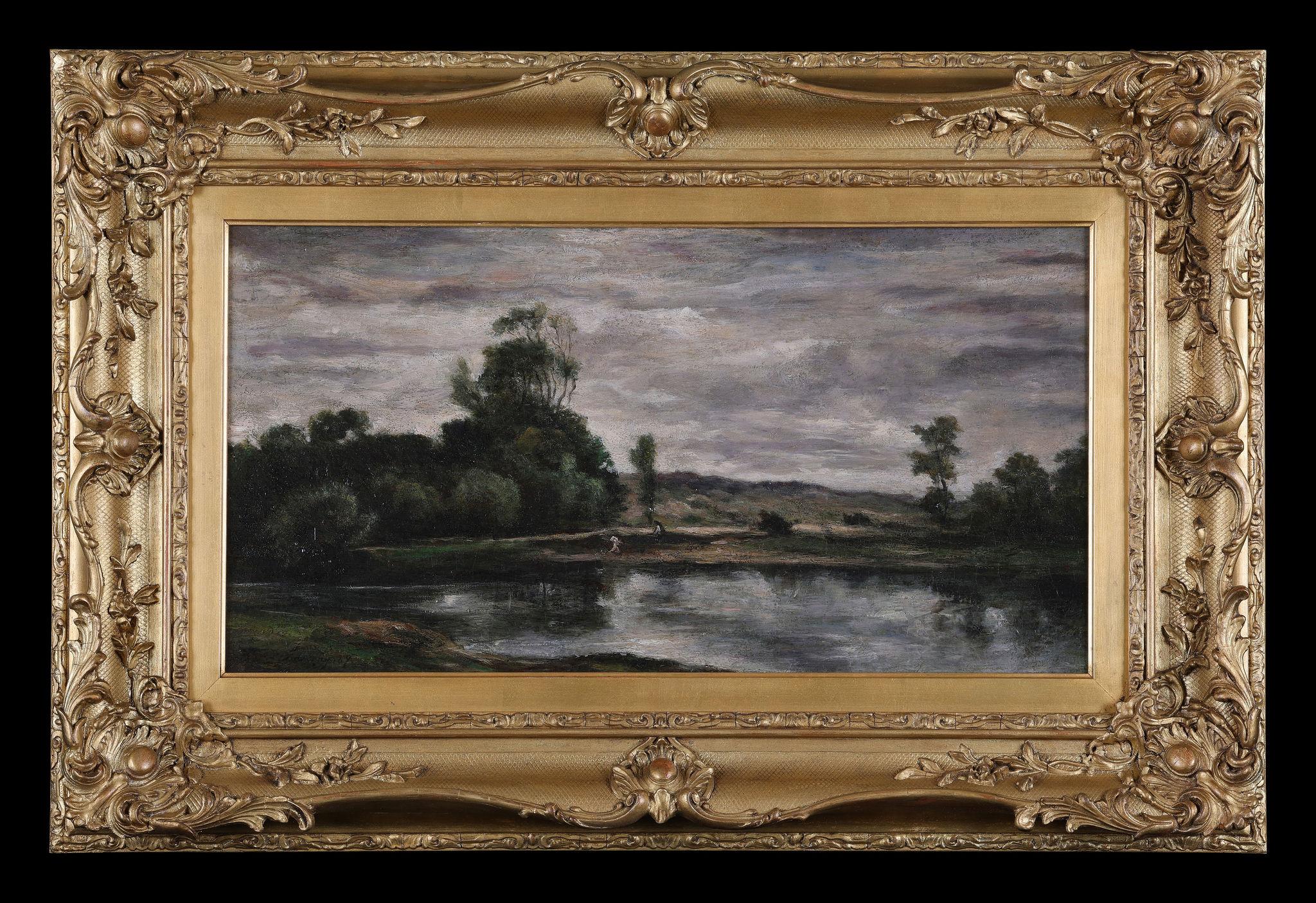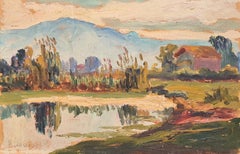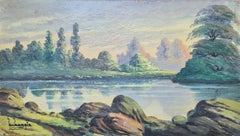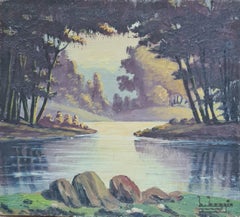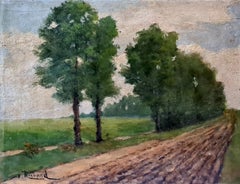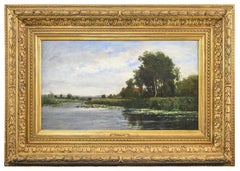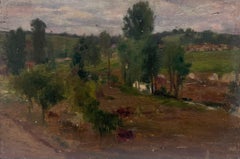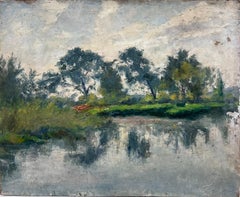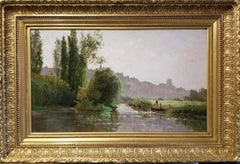Items Similar to Barbizon School, French River Landscape, Oil on Canvas, The Seine
Video Loading
Want more images or videos?
Request additional images or videos from the seller
1 of 18
François MauryBarbizon School, French River Landscape, Oil on Canvas, The Seine1884
1884
$1,084.96
£812.12
€920
CA$1,493.22
A$1,664.35
CHF 873.23
MX$20,324.40
NOK 11,056.94
SEK 10,450.49
DKK 7,003.69
About the Item
19th century French Barbizon school oil on canvas river view, possibly the Seine near Paris, by François Maury. The painting is signed top right, dated and there is a location which is as yet undeciphered. The painting is on a good stretcher with keys and presented in a gold patinated wood frame.
This painting, a serene landscape painting, masterfully captures a tranquil riverside scene. The composition features a lush tree-lined path on the left, providing a natural contrast to the gentle flow of the river beside it. The soft blend of greens and blues creates a calming, immersive atmosphere. The sky, an expansive element of the painting, is subtly rendered with varying shades of blue and hints of white, suggesting a gentle, overcast day. A solitary figure walking along the path adds a sense of scale and quiet contemplation, inviting the viewer to ponder the harmony of nature and solitude. The brushwork is expressive yet controlled, evoking movement in the river and life in the foliage. This piece stands out for its ability to convey peace and introspection, drawing the observer into its serene world.
Very much a painting of the circle of Corot and the Barbizon school, today, Corot is considered the forerunner of the Barbizon movement which played a major role in establishing naturalism in French landscape painting. Other artists associated with the group include Théodore Rousseau, Jean-François Millet, Charles-François Daubigny, Narcisse-Virgile Diaz de la Peña, Jules Dupré, Constant Troyon, Léon Richet and Honoré Daumier.
François Maury was listed in 1876, at the age of 15, at 1 rue des Trois-Mages in Marseille with the profession of painter. He studied at the École des Beaux-Arts in Marseille, where he won first prizes in painting and drawing in 1880, and the following year the Jules Cantini prize. He continued his artistic training at the Académie Julian in Paris. From 1885 to 1905, he exhibited at the Salon des artistes Français, of which he became a member, and at the Salon d'Automne in Paris.
It is mainly in landscape and portraiture that he asserts his talent. He painted the landscapes of his native Provence, Savoy and Paris. He animated some of his works with joyful scenes, curvy women, nymphs or legendary characters that were reminiscent of the painting of Adolphe Monticelli, by whom he was very influenced and whom he admired.
- Creator:François Maury (1861 - 1933, French)
- Creation Year:1884
- Dimensions:Height: 12.21 in (31 cm)Width: 14.57 in (37 cm)Depth: 1.38 in (3.5 cm)
- Medium:
- Movement & Style:
- Period:
- Condition:Some wear and losses to the frame.
- Gallery Location:Cotignac, FR
- Reference Number:Seller: LG/Maury1stDibs: LU1430216389722
About the Seller
5.0
Platinum Seller
Premium sellers with a 4.7+ rating and 24-hour response times
Established in 2000
1stDibs seller since 2020
248 sales on 1stDibs
Typical response time: <1 hour
- ShippingRetrieving quote...Shipping from: Cotignac, France
- Return Policy
Authenticity Guarantee
In the unlikely event there’s an issue with an item’s authenticity, contact us within 1 year for a full refund. DetailsMoney-Back Guarantee
If your item is not as described, is damaged in transit, or does not arrive, contact us within 7 days for a full refund. Details24-Hour Cancellation
You have a 24-hour grace period in which to reconsider your purchase, with no questions asked.Vetted Professional Sellers
Our world-class sellers must adhere to strict standards for service and quality, maintaining the integrity of our listings.Price-Match Guarantee
If you find that a seller listed the same item for a lower price elsewhere, we’ll match it.Trusted Global Delivery
Our best-in-class carrier network provides specialized shipping options worldwide, including custom delivery.More From This Seller
View AllBarbizon School Landscape, Le Moucherotte. Oil.
Located in Cotignac, FR
Early 20th Century French Barbizon School of a lake and cottage by G Jouyet. The painting is signed bottom left and there is a birthday inscription, signature and title to the back o...
Category
Early 20th Century Barbizon School Landscape Paintings
Materials
Oil, Cardboard
Barbizon Lakeside Landscape With Poplar Trees. Oil on Board.
Located in Cotignac, FR
An oil on panel idyllic landscape by Boggio. The painting is signed bottom left.
An idealised lakeside landscape view with poplar trees in the style of the Barbizon school.
Category
Mid-20th Century Barbizon School Landscape Paintings
Materials
Oil, Board
Barbizon School Lakeside Landscape, The Shady Glen. Oil on Board.
Located in Cotignac, FR
An oil on panel idyllic landscape by Boggio. The painting is signed bottom right.
An idealised lakeside landscape view of a shady glen in the style of the Barbizon school.
Category
Mid-20th Century Barbizon School Landscape Paintings
Materials
Oil, Board
Barbizon School Landscape, The Poplar Trees, Late 19th Century Oil on Wood Panel
Located in Cotignac, FR
Late 19th Century French Barbizon School oil on wood panel of poplar trees in a landscape by Richard. The painting is signed bottom left. The painting is on a quality chamfered panel.
A very charming, almost impressionist, rendition of a line of iconic French trees in a landscape. Before them an earth drive has been ploughed up by the wheels of passing carts and horses. Richard has created a wonderful perspective that draws us in to the painting and he has created a contrast between the strong greens of the trees and fields against the whites and blues of the sky. The painting is reminiscent of the works of Monet from the 1890s. to whom the poplar trees were a continuing inspiration.
The Barbizon school of painters was part of an art movement towards Realism in art, which arose in the context of the dominant Romantic Movement of the time. The Barbizon school was active roughly from 1830 through 1870. It takes its name from the village of Barbizon, France, on the edge of the Forest of Fontainebleau, where many of the artists gathered. Most of their works were landscape paintings, but several of them also painted landscapes with farmworkers, and genre scenes of village life. Some of the most prominent features of this school are its tonal qualities, colour, loose brushwork, and softness of form.
The leaders of the Barbizon school were: Théodore Rousseau, Charles-François Daubigny, Jules Dupré, Constant Troyon, Charles Jacque, and Narcisse Virgilio Díaz. Jean-François Millet lived in Barbizon from 1849, but his interest in figures with a landscape backdrop sets him rather apart from the others. Jean-Baptiste-Camille Corot was the earliest on the scene, first painting in the forest in 1829, but his work has a poetic and literary quality which sets him somewhat apart. Other artists associated with the school, often pupils of the main group, include: Henri Harpignies, Albert Charpin, François-Louis Français and Émile van Marcke.
In 1824 the Salon de Paris exhibited works of John Constable, an English painter. His rural scenes influenced some of the younger artists of the time, moving them to abandon formalism and to draw inspiration directly from nature. Natural scenes became the subjects of their paintings rather than mere backdrops to dramatic events. During the Revolutions of 1848 artists gathered at Barbizon to follow Constable's ideas, making nature the subject of their paintings. The French landscape became a major theme of the Barbizon painters.
Millet extended the idea from landscape to figures — peasant figures, scenes of peasant life, and work in the fields. In The Gleaners (1857), for example, Millet portrays three peasant women working at the harvest. Gleaners are poor people who are permitted to gather the remains after the owners of the field complete the main harvest. The owners (portrayed as wealthy) and their laborers are seen in the back of the painting. Millet shifted the focus and the subject matter from the rich and prominent to those at the bottom of the social ladders. To emphasize their anonymity and marginalized position, he hid their faces. The women's bowed bodies represent their everyday hard work.
In the spring of 1829, Jean-Baptiste-Camille Corot came to Barbizon to paint in the Forest of Fontainebleau, he had first painted in the forest at Chailly in 1822. He returned to Barbizon in the autumn of 1830 and in the summer of 1831, where he made drawings and oil studies, from which he made a painting intended for the Salon of 1830; "View of the Forest of Fontainebleau'" (now in the National Gallery in Washington) and, for the salon of 1831, another "View of the Forest of Fontainebleau"'. While there he met the members of the Barbizon school: Théodore Rousseau, Paul Huet, Constant Troyon, Jean-François Millet, and the young Charles-François Daubigny.
During the late 1860s, the Barbizon painters attracted the attention of a younger generation of French artists studying in Paris. Several of those artists visited Fontainebleau Forest to paint the landscape, including Claude Monet, Pierre-Auguste Renoir, Alfred Sisley and Frédéric Bazille. In the 1870s those artists, among others, developed the art movement called Impressionism and practiced 'plein air' painting. In contrast, the main members of the school made drawings and sketches on the spot, but painted back in their studios.
The Post-Impressionist painter Vincent Van Gogh studied and copied several of the Barbizon painters as well, including 21 copies of paintings by Millet. He copied Millet more than any other artist. He also did three paintings in Daubigny's Garden.
The Barbizon painters also had a profound impact on landscape painting in the United States. This included the development of the American Barbizon school by William Morris Hunt. Several artists who were also in, or contemporary to, the Hudson River School studied Barbizon paintings for their loose brushwork and emotional impact. A notable example is George Inness, who sought to emulate the works of Rousseau. Paintings from the Barbizon school also influenced landscape painting in California. The artist Percy Gray...
Category
Late 19th Century Barbizon School Landscape Paintings
Materials
Oil, Wood Panel
French Impressionist Barbizon School Landscape, Forest at Mont-de-l'Enclus
By Georges Guerin
Located in Cotignac, FR
1930s French Impressionist Barbizon School oil on panel view of a forest by Georges Guerin (1910-1984). The painting is signed bottom left and is also titled and dated to the back of...
Category
1930s Impressionist Landscape Paintings
Materials
Oil, Board
Impressionist Barbizon School Oil on Board Landscape, The 'Gorges de la Bourne'
By Georges Guerin
Located in Cotignac, FR
1930s French Impressionist Barbizon School oil on panel view of a river gorge by Georges Guerin (1910-1984). The painting is signed bottom right and also signed top left to the back of the board. The painting is also titled and dated to the back of the board, 'Gorges de la Bourne, Pont en Royans, Aout 1937.'
A very charming view of a river passing through a gorge and leading to a sunlit and colourful rocky cliff face. Guerin has achieved a wonderful play between light and shade, bright and sombre colours making it at once classical in interpretation and yet also modern and abstract. His technique of thick impasto technique worked with a brush is especially successful and gives the paintings surface a charming quality.
Guerin is noted for his landscapes as well as for his Paris street scenes and views of the Brittany coast.
The Gorges de la Bourne or Bourne Gorge is a canyon at the bottom of which flows the River Bourne. It connects Pont-en-Royans to Villard-de-Lans in...
Category
1930s Impressionist Landscape Paintings
Materials
Oil, Board
You May Also Like
French Barbizon landscape of a riverside
By Karl Daubigny
Located in New York, NY
Pristine condition.
Category
19th Century Barbizon School Landscape Paintings
Materials
Oil, Wood Panel
Fine Antique French Impressionist Signed Oil Painting Dusky River Landscape
Located in Cirencester, Gloucestershire
French Landscape
by Charles Martin-Sauvaigo (French 1881-1970) * see notes below
French Impressionist painter
oil painting on wooden panel
unframed
size: 9.5 x 6.25 inches
condition:...
Category
Early 20th Century Impressionist Landscape Paintings
Materials
Oil
Fine Antique French Impressionist Signed Oil Painting Beautiful River Landscape
Located in Cirencester, Gloucestershire
River Landscape
by Charles Martin-Sauvaigo (French 1881-1970) * see notes below
French Impressionist painter
oil painting on wooden panel
unframed
size: 13 x 16 inches
condition: ve...
Category
Early 20th Century Impressionist Landscape Paintings
Materials
Oil
ÉTANG DEVANT UNE VILLE river landscape French 19thC oil canvas tranquil Barbizon
By Edmond Marie Petitjean
Located in New York, NY
Edmond Petitjean
French, 1844-1925
Etang devant une ville
Oil on canvas
18.3 x 31.1 inches
Framed: 27 ½ x 40 inches
Signed lower left: E Petitjean
Provenance:
Private Collection,...
Category
Early 20th Century Barbizon School Paintings
Materials
Oil, Canvas
"a Fontainebleu, " Charles Francis DeKlyn, Barbizon, Oil, French Countryside
Located in Wiscasset, ME
Charles Francis De Klyn was born in Westchester County, New York, in 1865. A landscape, marine, portrait and figure painter, De Klyn studied in New York and Paris from 1886 to 1891, then taught at the Cleveland Art Club and the Cleveland School of Art. In 1893, he was one of the founders of the Cleveland Brush and Palette Club, and he exhibited at the National Academy of Design in 1894 and 1895. He was also a member of the Society of Western Artists.
"A Fontainebleu" by Charles Francis De Klyn is a beautifully rendered Barbizon oil...
Category
Late 19th Century Barbizon School Landscape Paintings
Materials
Oil, Panel
A River Landscape
By Karl Daubigny
Located in St. Albans, GB
Karl Pierre DAUBIGNY
With price reaching upwards of $36 000 this is opportunity to purchase a piece by an artist who was at the forefront of the impressionist movement at a price that has great potential investment. It has excellent provenance coming from the continent via Christies in the 1980s and is in many important museums from the
Musée d’Orsay, Paris to the Rijksmuseum, The Hague.
Oil on panel
Panel size: 11 x 21" (28 x 54cm)
Outside frame size: (48 x 74cm)
Born on 19 June 1846 in Paris and died on 25 May 1886
Painter of animals, landscapes, marines in both oil and watercolours
Karl Pierre Daubigny was the son of, Charles Francois Daubigny, one of the original eight Barbizon painters and one of the leading landscapists of his time. Taught by his father, who greatly influenced him, Karl Daubigny travelled the French countryside painting...
Category
1860s Barbizon School Landscape Paintings
Materials
Oil
